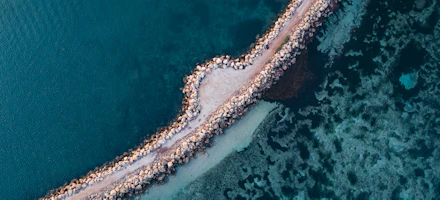
Australia's Coral Coast's National Parks
14 April 2022
Everything you need to know about Australia's Coral Coast's National Parks.
Australia’s Coral Coast has an incredible range of diverse national parks, ranging from yellow sand deserts to deep red gorges, to turquoise waters teeming with marine life. When visiting these parks, it is important to follow the “Leave No Trace” principle to ensure the conversation of these parks so they can be enjoyed by visitors for years to come. Be sure to bring adequate water supplies and sun protection as many of these parks have limited facilities. Entrance fees apply for visiting these national parks, or purchase a Parks Pass. Here is everything you need to know about Australia’s Coral Coast National Parks.
Cape Range National Park
Cape Range National Park is the access point to the World Heritage listed Ningaloo Marine Park, located 30 minutes from Exmouth. This national park is best known for its incredible limestone ranges that stretch across the 50,581 hectares of land and over 60 kilometres of pristine beaches with spectacular snorkelling. Popular snorkelling spots include Turquoise Bay, Lakeside and Oyster Stacks. Camping is available in the park, advance bookings required.
Explore the many walking trails in Cape Range. Take the universal access 0.6km Yardie Nature Walk for views into the Yardie Gorge. From here, the more adventurous can continue onto the more challenging Yardie Creek Gorge Trail (2km return). Keep an eye out for the black-footed rock wallabies that live here!
The Mandu Mandu gorge trail (3km) takes you over the dry creek bed before ascending the ridge of the gorge, offering stunning views across the Ningaloo coast.
Head to the eastern side of Cape Range to visit the Thomas Carter Lookout off Charles Knife Road. The Badjirrajirra Loop Trail (8km, reasonable level of fitness required) begins here and takes hikers through the gorges and surrounding bushland with scenic views.
Make sure to stop by the Milyering Discovery Centre to learn more about the wonders of the Ningaloo Coast World Heritage Area.
Nambung National Park
Nambung National Park, about 20 minutes from the coastal town of Cervantes, is home to the unique Pinnacles Desert. The Pinnacles are thousands of yellow limestone pillars formed over 25,000 years ago, rising from the sandy landscape. Explore the Pinnacles by car on the one-way 4.5km sandy loop trail (2WD accessible).
Pull aside in the marked bays to safely to explore this otherworldly landscape. Head to the accessible lookout platform in the middle of the loop for glimpses of the Indian Ocean in the distance. Before leaving, head to the Pinnacles Desert Discovery Centre to learn more about the history, geology and wildlife of the park.
Dirk Hartog Island National Park
Dirk Hartog Island National Park is located 40km west of Denham in the Shark Bay World Heritage area. As the first recorded landing on Australian soil by Europeans in 1616, this island holds much historical significance.
Offering stunning natural landscapes and endless white sand beaches, the national park is accessible by air or boat transfers. Self-drive 4WD vehicle access is available via a barge transfer from Steep Point between March to October. Alternatively, explore the island with a fishing or 4WD tour from Denham. Visitors can stay overnight on the island, with an eco-resort and camping available at the Dirk Hartog Island Lodge. Take a walk along some of the tallest sea cliffs in Australia on the western coast of the island and marvel at the natural wonders of this island.
Francois Peron National Park
Located just outside of Denham in Shark Bay, Francois Peron National Park is best known for its striking red cliffs and turquoise blue water. The Peron Peninsula, or Wulyibi as known to the traditional owners the Malgana people, was a pastoral station until 1990 before being declared a national park in 1993.
Learn about the farming history of the area with a visit to the Peron Heritage Precinct and old homestead. Explore the property on a self-guided walk, before taking a dip in the artesian spring hot tub. Whilst the Precinct is 2WD accessible, a high clearance 4WD is required in the national park. Join a full day guided 4WD tour with a local operator to explore the natural wonders that await.
At Skipjack Point, spot marine life from the cliffside lookout. Keep an eye out for dolphins, dugongs, turtles and rays in the water below. Camping is available within the park with campsites on a first come, first served basis. The best time to visit is during the cooler months from May to October, which coincides with when winds are the lightest.
Kalbarri National Park
Kalbarri National Park is located just outside of Kalbarri town. This large park covers over 186,000 hectares in size and has many scenic hikes. The scenery consists of red sandstone gorges with unusual rock formations carved out by erosion. Nature’s Window is one of the most iconic sights in the park with a natural rock arch overlooking the river.
Stop by the latest attraction, the Kalbarri Skywalk. Here you will find two distinctive lookout platforms perched on the cliff edge. Learn about the cultural significance of the region to the traditional owners, the Nanda people. Interpretive signage shares the culture and dream time stories of the Nanda people.
Within the National Park are several walks and hiking trails. The Z Bend Lookout trail (1.2km return) is a gentle walk taking you to a lookout over the river. You can then choose to tackle the more challenging Z Bend River Trail (2.6km) from here. Longer hikes within the Park include the moderately challenging Loop Trail (8km return), which starts and ends at Nature’s Window. During the warmer summer months, the Loop Trail is closed from 7am for hikers’ safety.
Lesueur National Park
Lesueur National Park is a biodiversity hotspot located 20 minutes from Jurien Bay. A hub for flora and fauna, this park is thought to be home at least 10 percent of Western Australia’s flora species. Best visited in late winter and spring when the park begins to bloom with colourful wildflowers.
Explore the park on the one-way scenic loop drive. Regular pull-in bays provide opportunities to park to take in the scenery or take photos of the wildflowers. Explore the area on foot with a bush walk on the Lesueur trail (3.5km) and head towards the summit of the trail for scenic views across to the Indian Ocean. The Yued Ponar Trail (6km loop) begins and ends at the Cockleshell Gully picnic area.



























